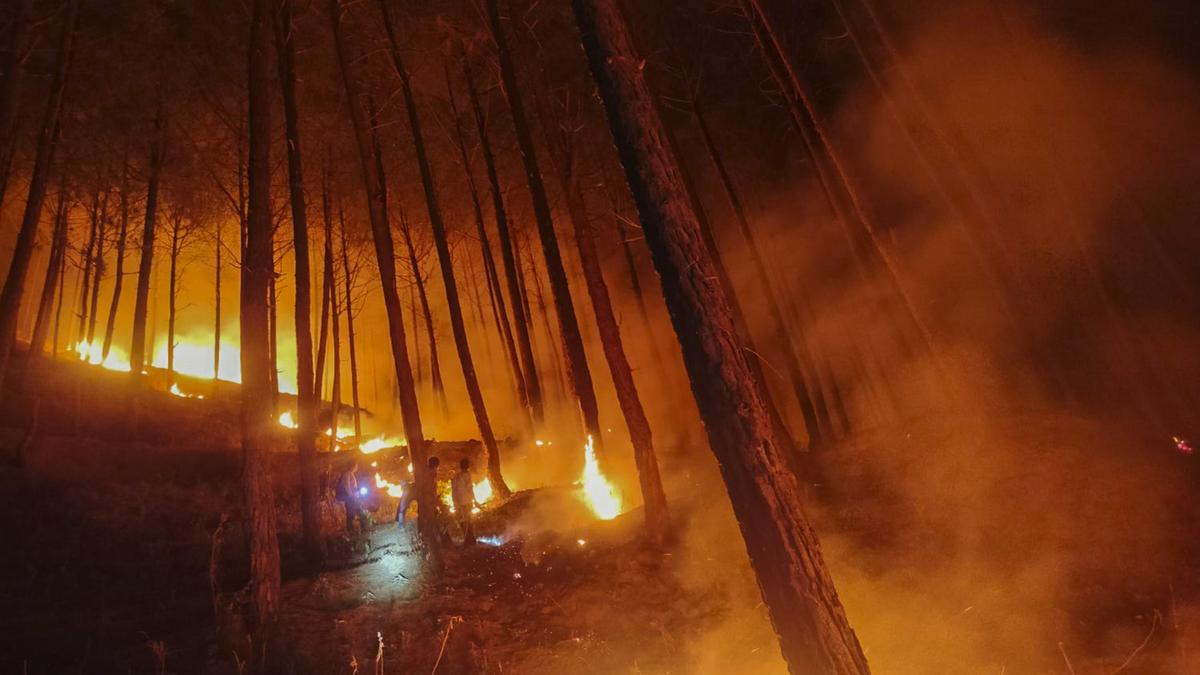
Uttarakhand wildfires flare up again after brief lull
The Hindu
Forest fires rekindle in Uttarakhand, affecting Rajaji Tiger Reserve and Nilkanth Mahadev temple trek route, causing significant damage.
Forest fires have flared up again in various parts of Uttarakhand, with two major fire incidents in the Gauhari range of the Rajaji Tiger Reserve and the trek route to Nilkanth Mahadev temple in Rishikesh.
The blaze that broke out in Gauhari range of the reserve on Thursday evening affected around 1.5 hectares of forest cover, Rajaji Reserve Director Saket Badola said on May 31.
“The fire in Gauhari range of the reserve has been brought under control but fire fighting continues in an area spread over one hectare in the forest near Pundrasu along the trek route to the Nilkanth Mahadev temple,” Mr. Badola said.
“The forests in Barahat, Mukhem, Dunda and Dharasu ranges besides Varunavat hills in the border district of Uttarkashi are also ablaze,” Uttarkashi District Disaster Management Officer Devendra Patwal said.
“Forest guards, Quick Response Teams, NDRF, SDRF, police and fire brigade personnel are busy dousing the flames in Uttarkashi district,” he said.
After nearly a fortnight-long lull which saw a substantial decline in forest fire incidents, wildfires flared up on Thursday with fire incidents in 11 areas affecting more than 13 hectares of forest land across the State, Additional Chief Conservator of forest Nishant Verma said.
“There have been 1,167 forest fire incidents this season in which nearly 1,600 hectares of land have been affected,” he said. “Forest fires in Uttarakhand have so far claimed six lives and left five persons injured,” Mr. Verma said.

“Writing, in general, is a very solitary process,” says Yauvanika Chopra, Associate Director at The New India Foundation (NIF), which, earlier this year, announced the 12th edition of its NIF Book Fellowships for research and scholarship about Indian history after Independence. While authors, in general, are built for it, it can still get very lonely, says Chopra, pointing out that the fellowship’s community support is as valuable as the monetary benefits it offers. “There is a solid community of NIF fellows, trustees, language experts, jury members, all of whom are incredibly competent,” she says. “They really help make authors feel supported from manuscript to publication, so you never feel like you’re struggling through isolation.”

Several principals of government and private schools in Delhi on Tuesday said the Directorate of Education (DoE) circular from a day earlier, directing schools to conduct classes in ‘hybrid’ mode, had caused confusion regarding day-to-day operations as they did not know how many students would return to school from Wednesday and how would teachers instruct in two modes — online and in person — at once. The DoE circular on Monday had also stated that the option to “exercise online mode of education, wherever available, shall vest with the students and their guardians”. Several schoolteachers also expressed confusion regarding the DoE order. A government schoolteacher said he was unsure of how to cope with the resumption of physical classes, given that the order directing government offices to ensure that 50% of the employees work from home is still in place. On Monday, the Commission for Air Quality Management in the National Capital Region and Adjoining Areas (CAQM) had, on the orders of the Supreme Court, directed schools in Delhi-NCR to shift classes to the hybrid mode, following which the DoE had issued the circular. The court had urged the Centre’s pollution watchdog to consider restarting physical classes due to many students missing out on the mid-day meals and lacking the necessary means to attend classes online. The CAQM had, on November 20, asked schools in Delhi-NCR to shift to the online mode of teaching.









